All about growing room begonias
Many gardeners breed and acquire interesting varieties. begonias... But many do not know how to properly care for a purchased plant. Before placing a new pet on the windowsill, it is recommended that you read the information, which tells everything about room begonia. Then the beauty will delight with her riot not only flowers, but also gorgeous greenery for a long period.
Content:
- Indoor begonia: species and varieties
- Growing conditions
- Reproduction methods
- Watering and feeding
- Transfer
- Diseases and pests
Indoor begonia: species and varieties
Begonia - a wonderful creature that stands out for its palette of colors, not only colors, but also the foliage. It is represented in wildlife as a perennial and annual bush.
It has the property of stretching up to 1.5-2 meters, while releasing both small peduncles up to 2 cm and rather large flowers, 30 cm in diameter. The shrub can appear in the form of erect stems, as well as in the form of a creeping plant.
There are more than 1,500 thousand species of varieties, but only 125 types are used for breeding at home and on personal plots. Breeders conditionally represent several groups in which types of begonias are collected:
- Blooming - decorative and beautifully flowering.
- Shrub.
- Decorative deciduous.
- Tuberous.
The flowering subspecies is a bright inflorescence of bright colors. Flowers bloom in different forms, both simple and double. Each species is original and beautiful in its own way. The most popular representatives of flowering begonia among gardeners are distinguished:
- Eternal flowering - includes many varieties. Their main distinguishing feature is their profuse, bright bloom during the summer period, starting in mid-spring. Weather conditions have no influence on growth and development (Baby Wing, Ambassador, Cocktail).
- Elatior are shrubs of medium height, not exceeding 40 cm in height, distinguished by bright saturated color leaves (up to 8 cm) and a year-round budding period (Piccora, Annabell, Louise, Bellona).
- Gloire de Lorrain is a sprawling shrub with flowers that slope downward. The leaves appear in a light green color with a characteristic red core inside. Flowering occurs in the first month of autumn and ends only in early February (Rosemary, Competitor, Marina).
Shrub representatives are distinguished by long branches, similar to bamboo stalks, on which a bunch of flowers is thrown out. The latter are not impressive in their size. They are collected in inflorescences, creating the appearance of a densely flowering shrub. There are the following types:
- Coral - the height of the bush is up to 1 meter, does not differ in abundant flowering, the color of the leaves is standard - light green, ovoid.
- Fuchsia - the leaves are small, they stretch 1 meter in height, the flowers resemble drooping fuchsia, and the color color varies in all shades of scarlet.
Ornamental-deciduous specimens do not produce erect stems, they have very developed foliage. It comes straight from the roots, impressive in its size and color. The most interesting views:
- Royal (Rex) - a hybrid, the growing leaves boast 30 cm in diameter with uneven, pubescent fine border or cut edges. The appearance is represented by a varied palette (from pale brown to purple or cherry purple).
- Metallic - the greenery is oval in shape, small in size (10-15 cm in girth), outwardly resembling a maple leaf, has a fluffy dusting on top.
- Brindle - stands out with small leaves with small bright dots of light color.
Tuberous begonia differs from all previous varieties by the presence of a tuber instead of root system... It has the ability to stretch 80 cm up. Inflorescences in different varieties vary 5-20 cm in volume, simple or double. Flowering begins in late spring and lasts until early October. Bright representatives of the type:
- Pikoti Harlequin - grows up to 25 cm, voluminous flowers (up to 15 cm), yellow tone.
- Bud de Rose is a pink shade of large double inflorescences held on a compact stem.
- Duck Red - externally, the inflorescences resemble a peony, bright scarlet, large double. The stalk is undersized, massive, the leaves are glossy, finely toothed, large in size.
A large number of varieties are united under one name "Begonia". What all varieties have in common is the original color and external shape of the leaves, which allows gardeners to collect more and more varieties of varieties.
Growing conditions
Begonia is a rather unpretentious creature, you just need to find an approach to it and it will delight not only with long flowering, but also with the excellent development of the stem mass:
- The shrub loves elevated air degrees - in the summertime the temperature of + 24 + 26C is comfortable for it, and in winter it is recommended to give the plant a rest and gain strength, while the temperature should not exceed + 14 + 16C.
- Begonia loves not only warmth, but also bright light. But you should not abuse the southern side, the bright midday rays of the luminary burn the delicate juicy foliage and petals of the inflorescences. Western and eastern window sills are ideal, where there is enough sunshine, dimmed at lunchtime. To form a beautiful bush, you should periodically scroll the flowerpot, turning the undeveloped side to the light. The bush normally refers to movement and does not drop foliage unnecessarily.
- Humidity is necessary for begonias, it is sensitive to spraying from a spray bottle and responds with exuberant flowering and active growth. But in no case should you overdo it with irrigation - the remaining wet areas on the foliage can develop into rotten spots. To avoid this fate of the shrub, you should resort to another method of increasing the moisture around the flower. It is required to place a drainage from expanded clay or pebbles into the pallet, periodically pour water into the container. The latter will evaporate and humidify dry air.
Reproduction methods
The main point in growing begonia is the recommendation not to try to propagate it by seeds. This breeding method is recommended to be left to breeders. The method is quite laborious and most often does not bring the desired result. For sowing planting material, work should begin in February-March.
Seeds are best purchased at a specialized store. Seedlings are planted shallowly into the soil mixture. The latter consists of sand, peat and garden soil, combined in equal quantities. After sowing, moisturize well. Rapid germination is possible with bright lighting, low room temperature and high humidity levels. Otherwise, all efforts will be in vain, the seeds will not be able to sprout, rotting at the root.
The most reliable and fastest propagation methods are: cuttings, stems, tubers or roots.
A leaf protrudes in the form of a cutting. A new bush can grow from a leaf with a shank, without a shank, and when part of a leaf plate is planted.If it is possible to cut the stalk together with the leaf attached to it. The stalk should be left 3-4 cm long so that it can be well buried in the ground. Make a mini greenhouse on top for faster germination. If there is only one leaf with a leg, you need to cut the leaf part so as not to touch the massive veins. Each of the individual pieces with a thick vein is buried 1.5-2 cm into the ground and covered with a transparent jar or plastic bag.
Roots or club - the easiest way to divide. It is necessary to divide the planting material in such a way that one bud remains at the top of each of them, which will then grow. The cut is made with a clean, sharp garden tool, and then sprinkled with crushed activated carbon or ashto prevent infection. After dividing, each of the parts is placed in a separate pot and watered abundantly. Breeding is recommended in early spring. It is this period that is favorable for active rooting and development of a young plant.
Watering and feeding
Watering for the bush is very important and necessary. In the summer heat, the flowerpot should be viewed before irrigation - if the ground is still wet, then you should not moisten it. Otherwise, when the soil dries quickly, it is recommended to water it 1-2 times a day.
It is worth taking care not to overflow; due to abundant moisture, stagnation of moisture can form. The latter can provoke the acquisition of diseases or decay of the root system.
In the winter months, watering is reduced and done as needed - once a week.
The main criterion for irrigation at this time is the drying out of the soil 15 cm deep. Water for humidification should not be alkaline, but at room temperature and previously settled.
It is imperative to apply fertilizers for beautiful growth and lush flowering:
- Top dressing should be applied every 12-14 days. The procedure must be carried out in the evening, before that, having previously moistened the soil. It is worth controlling so that the bait does not fall on the leaves and stem - it can burn.
- To enrich the soil with potassium and fluorine, it is recommended to use Begonia, a fertilizer special for the plant. And the preparation Bona Forte for violets and begonias will protect well from pests and the influence of the surrounding climate.
Thus, carefully controlled watering and periodic feeding will allow the plant to grow, and will also prevent the formation of diseases.
Transfer
Compulsory care is not as important as an annual plant transplant is necessary. It is recommended to carry out it in the spring. The most favorable time for the procedure is early March - late April.
Do not delay the process until May - at this time, the transplanted bush will acclimatize for a long time in the new place of residence. If the procedure is not completed on time or the transshipment period is completely missed, then the green plumage will fade and grind in a short time.
Transplant rules:
- When transplanting, you need to take a pot 2-3 cm larger than the previous flowerpot.
- Remove the bush from the old container, shave off the soil. The roots must be checked for rotten, damaged, if any, removed.
- Clean roots must be disinfected in a weak solution of potassium permanganate.
- Place drainage at the bottom of the flowerpot, fill in the soil purchased or prepared independently, which should include sand, peat, coniferous soil and leaf turf.
- Fill the pot to the middle, then set the plant and add the rest of the soil, tamping it tightly so that no air voids remain inside the pot.
- Then pour thoroughly with settled water.
Diseases and pests
No matter how beautiful it blooms and splendidly scatters its leaves, very often it is exposed to diseases and pests. I single out a list of the main diseases and problems inherent in begonia:
- Bacterial wilting - characterized by the appearance of blistering spots that grow in volumes on the surface of the leaves, covering the entire perimeter.
- Downy mildew - the leaves acquire a white soft bloom, which is initially localized on one leaf, and then spreads to the entire greenery of the bush.
- Botrytis - the appearance of black or brown rotten spots is noted, occurs with abundant moisture and in unventilated stuffy rooms.
Any disease is affected by a chemical agent that acts specifically for a specific type of bush ailment.
In addition to diseases, the plant can be attacked by harmful insects:
- Aphid - if twisted yellow leaves are found, it is worth examining the bush for the presence of small parasites. They suck out nutritious juices, thereby ruining the plant. Neutralize aphids, possibly when exposed to insecticides Fufanon or Actellik.
- Greenhouse thrips - large insects, visible at first appearance. Leaves, when they occur, stop growing and dry out. A soap solution helps in removing them.
- Leaf nematode - the upper part of the shrub acquires light spots on the leaves and peduncles, and then dies off altogether. Pest control does not lead to results, it is better to remove the plant and burn it so that the parasites do not move to other flowers.
- Spider mite - if a cobweb has formed on the bush, and the leaves have lightened, you need to look for a new inhabitant - a tick. It is killed by exposure to chemicals.
It is necessary to monitor the growth and development of your green pet, and when new spots or insects appear, immediately start treatment. If this is not done, the shrub can be lost. Thus, begonia is not as demanding in care as it is a tasty morsel for various diseases and harmful insects.
More information can be found in the video:



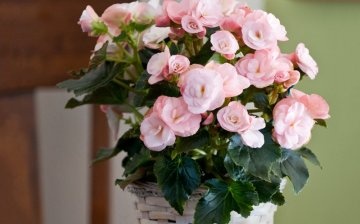
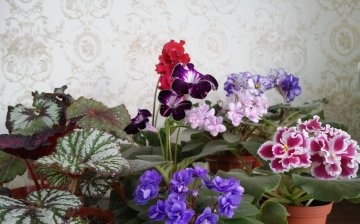
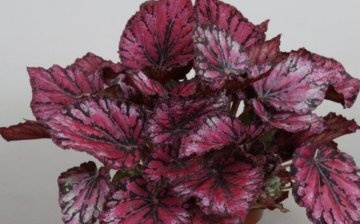
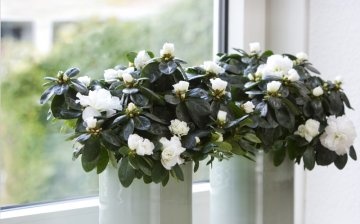


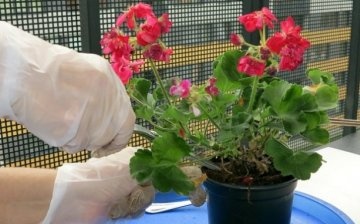
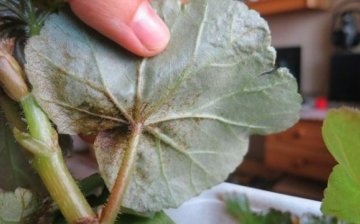








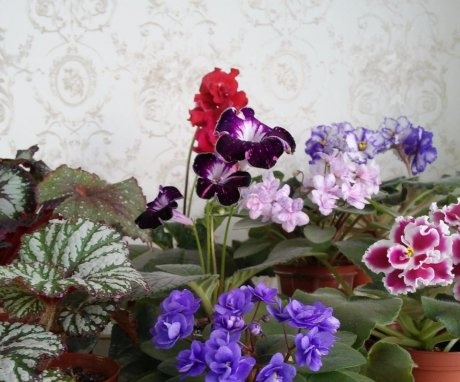
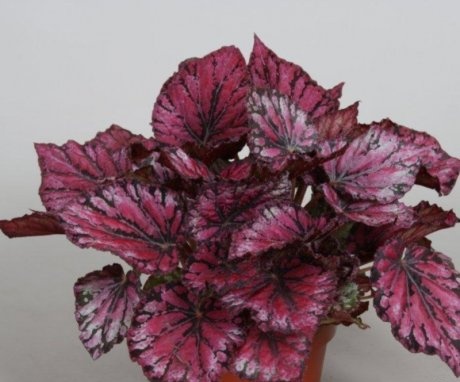
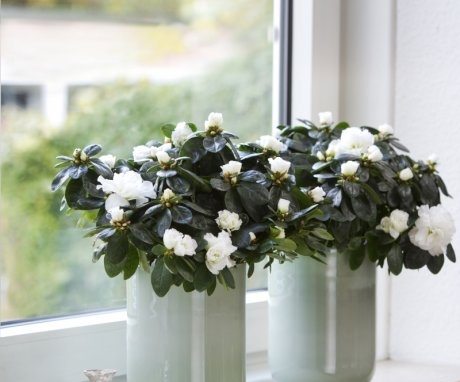
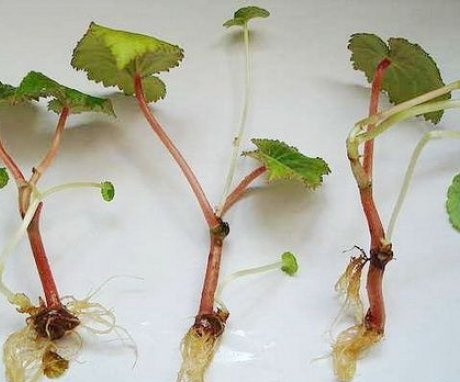
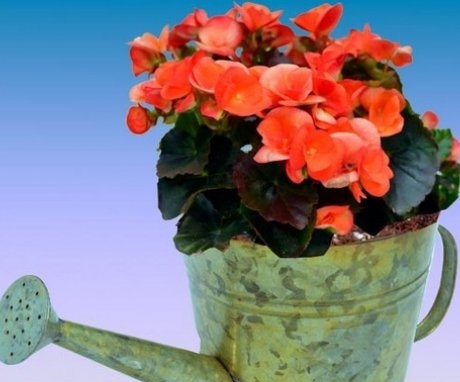
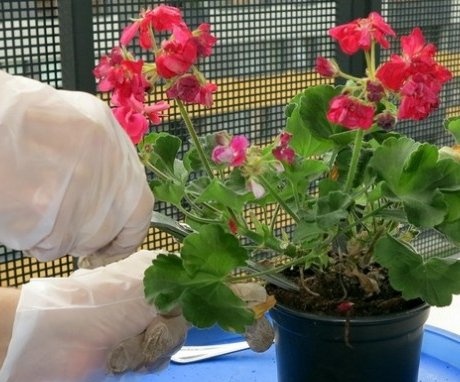
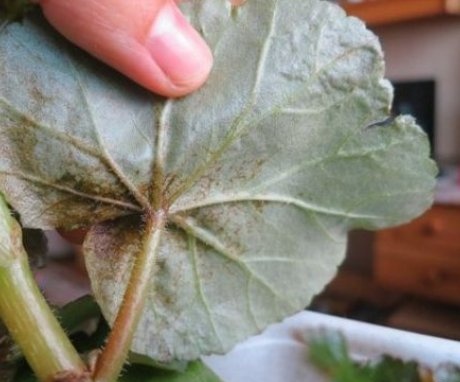
My windows face east and begonia grows simply gorgeous, obviously the diffused light is perfect for her. From time to time in the spring, I transplant it into a larger pot or plant it, as it grows quickly enough.
Begonia requires attention when watering and spraying. I try to water after two days and drain the excess water from the pan, and instead of spraying, I wipe the leaves with a soft, damp cloth.